Claussen Pickles are kosher dill pickles at their crunchiest, saltiest best! These homemade Claussen pickles taste like the commercial ones you find at the store, but better. And better yet, they’re ridiculously easy to make!
Whether you’re new to pickle making or a pickle veteran, you NEED to make these half sour pickles! And wonder of wonders, you don’t need to know how to can to make these super fresh, crunchy pickles! Claussen dill pickles are meant to be eaten fresh.
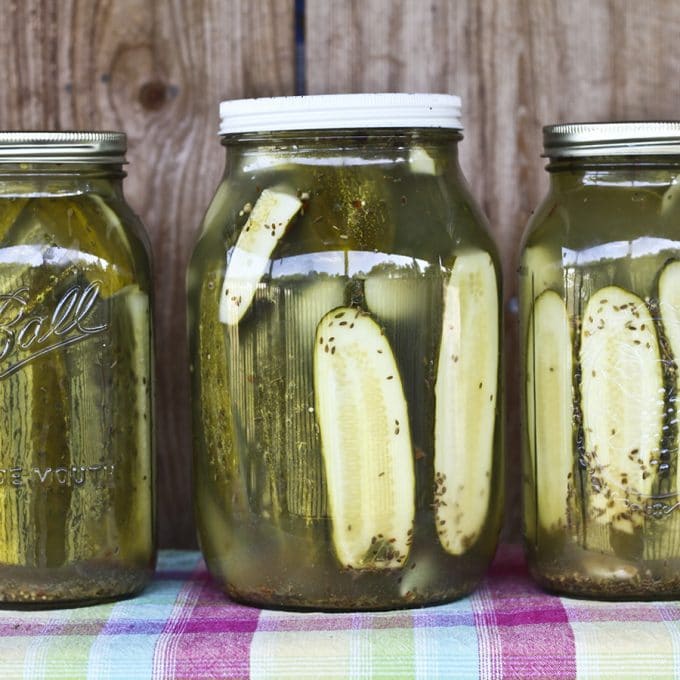
Homemade Claussen Knock-Off Pickles: Always crunchy and garlicky, this perfect homemade pickle recipe requires no special equipment, & no canning experience.
It’s common knowledge that I have a salty tooth rather than a sweet tooth. When the weather does what it has been doing lately (making us all do our best Shadrach, Meshach and Abednego impersonations) I can’t think of a single thing I find more refreshing than an icy-cold, salty, crunchy pickle.
It’s not just me, it’s my whole family: mother, sisters, brothers, cousins, aunts, grandparents, kids, husband… I married a man who loves pickles so much he eats the pickles and then drinks the juice from the jar.
I grew up eating my Grandma’s homemade dill pickles like the supply was endless and moved on to canning my own pickles as soon as I had a kitchen of my own. There’s just something about a homemade dill pickle that makes me happier than any pickled cucumber ever should.
My little sister, Jessamine, and I compare our homemade pickles from year to year the way some people compare wine vintages.
Dill Pickle Recipe
But there is one pickle that stands head-and-shoulders (were pickles to *have* heads and shoulders) above all others. I’m talking about the pickles you see here. That’s right: Homemade Claussen Dill Pickles.
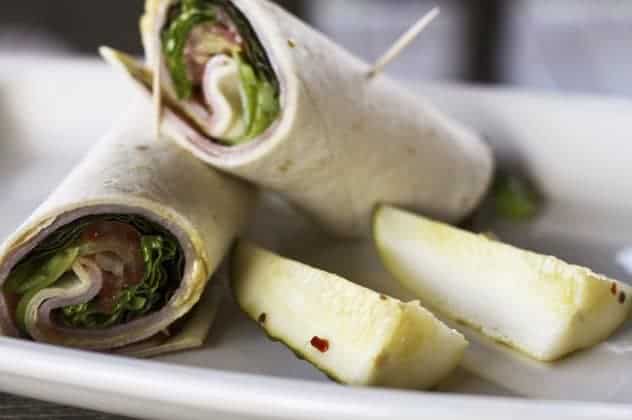
Recipe for Claussen Pickles
What do you need in order to make this recipe for Claussen Half Sour Pickles at home? Let’s get a quick list for both ingredients and equipment out of the way, shall we?
Equipment for Making Claussen Pickles at Home
- A Glass gallon jar or 4 glass quart jars or other food safe container with a tight fitting lid
- Measuring cup
- Chef’s knife or paring knife
Ingredients for Making Homemade Claussen Pickles Copycat
- Small to medium size pickling cucumbers (check your local farm stand or farmer’s market!)
- Apple Cider Vinegar (don’t fret- it doesn’t taste like apple cider and isn’t even a little sweet!) or white vinegar
- Kosher Salt
- Garlic
- Dill (either fresh or dill seed)
- Pickling spices (available here)
A quite note on your vinegar choice: I opt for apple cider vinegar because it’s a smoother vinegar than white vinegar. It does not impart any sweetness or apple taste to the pickles whatsoever.
If you can’t find it (pssst. It’s right next to white vinegar in even moderately stocked grocery stores) or don’t feel like buying it, you can most certainly substitute white vinegar. It’ll just taste a little sharper. (And technically store bought Claussen pickles have white vinegar, so you do you!)
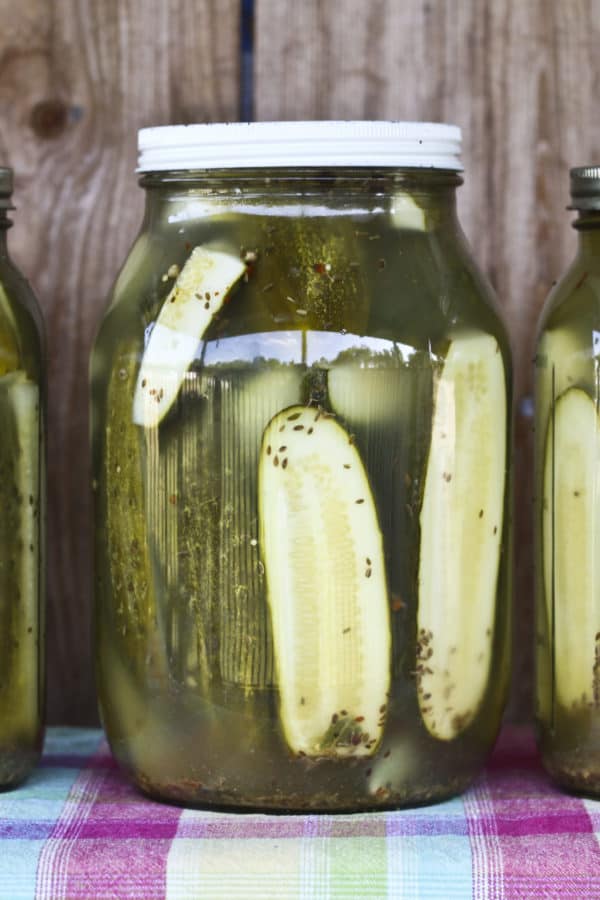
And ya’ll. These homemade half sour pickles are so easy to make it’s almost criminal.
The hardest part is the 2 to 4 day wait for them to be done. Truth be told, though, I’ve snacked on them the day after I made them and been a very happy camper.
Claussen Pickle Recipe
These are homemade refrigerated deli pickles, also known as Lithuanian half-sours, also known (in the commercial equivalent) as Claussen dill kosher pickles, also known as the best pickles ever known to mankind.
Here’s the thing. While I do love my other homemade pickles dearly (otherwise why would I continue canning ninety-something quarts year after year after year), these are by far my all-time favourites.
CRUNCH. That’s what you hear when you bite these. There is no flop, no squish, no soft pickles. These things almost bite back.
This also happens to be the perfect dill pickle recipe for beginning pickle makers. If you’re not into canning, these refrigerator pickles are a godsend. Even if you ARE canning obsessed, like yours truly, this Claussen pickle recipe should be in your pickle repertoire too.
Please note that this Claussen pickle recipe is not suitable for canning. The brine is fermented and not very acidic, which means it has far too high a PH to can safely. If you’re looking for a great canned dill pickle recipe, try this home canned garlic dill pickle recipe.
Refrigerator Pickles
Here’s where we get into the best part of this pickle recipe (aside from the crunch and flavor). You don’t have to cook anything to make these pickles; not one single thing. The brine is stirred together, the cucumbers are rinsed, trimmed and stuffed into a jar with garlic cloves and spices.
These half sour pickles are NOT CANNED. They are simply put into jars. Amen!
When it’s summer time and the idea of turning on the stove makes me want to crawl into an (air conditioned) hole, these pickles are a welcome treat. Not only is that cold crunchy refrigerator pickle waiting to cool me off at the end of the prep time, but I don’t have to heat up my kitchen by even one single degree to get there.
Remember that pickling isn’t just for cucumbers, either! Try out our Pickled Brussels Sprouts, Quick Pickled Red Onions, and famous Candied Jalapenos!
How to Make Pickles FAQ
Please, please, please give these a go even if you have never made a pickle before. There is nothing scary or intimidating here. Wash, slice, stuff, stir, pour, sit, wait.
- Trim 1/8-inch from the blossom end of each cucumber and slice them in half lengthwise or into quarters. The size you choose depends on how large your cucumbers are and how big you want the pickles to be when they’re done. This helps minimize the chances of soft pickles.
- In a gallon jar (or large, wide-mouth, food-safe container) layer the dill heads or seed, pickling spice or mustard seed, and garlic cloves and sliced cucumbers. If you’re dividing the cucumbers up between smaller containers, just divide the garlic and spices evenly between the containers, too.
- Stir your brine together in a separate container. You WILL have more brine than you have space for in the jars, but that’s why you pack the spices in the jars. Just store extra brine in a jar in the refrigerator and use it to top off your pickles if the brine starts evaporating.
- Pour the brine over the cucumbers, taking care to make sure all of them are fully submerged. If needed, place a plate or mug or other ziploc bagged can of beans on the cucumbers to weigh them down and keep them under the brine!
- Cover the jars lightly not tightly and leave out of direct sunlight on the counter for two to four days or until the pickles are picklicious.
- If your kitchen is pretty hot or humid, you can stash them directly in the refrigerator. They’ll just take a couple of days longer to get fabulous. Your patience will be rewarded.
On the plus side, the wait is only two to four days which is significantly less than the six week wait of the canned pickles. Besides, as I said, there is the crunch factor
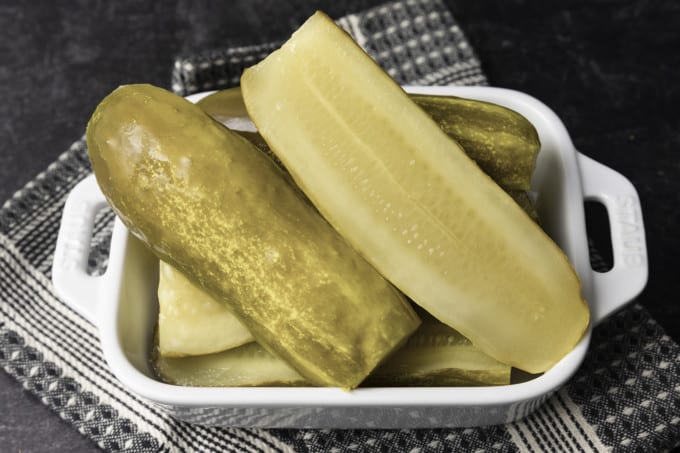
Troubleshooting Your Homemade Claussen Pickles
These pickles are easy peasy to make, but there still may be a couple of things that pop up from time to time that make you go “Hmmm…” In no particular order, here are some of the most commonly asked questions about them and some answers!
- Why is my pickle brine cloudy? Okay, I lied. This is the most common question and that’s because the brine becomes cloudy naturally as a consequence of fermentation (which is what’s happening here.) No worries.
It’s all natural. This half sour pickle recipe (more on this to come) is a fermented pickle recipe and that just happens.
Another possible cause of intense cloudiness or discolouration in your brine is using table salt. The iodine in table salt can also give off flavours to your pickles, so it’s best to stick with kosher salt or pickling salt for these bad boys! - Is the scum, foam, or film on top of my pickle brine dangerous? It’s that pesky (and delicious) fermentation again! This is another thing you don’t have to worry about.
Just scrape it off with a spoon, discard, and top off with a little of that extra brine you whipped up. (See the recipe card for details.) But do remove the scum or it could cause your pickles to go bad. - My pickles went soft! How do I prevent this? This particular tragedy could have two causes.
First, you may have failed to remove enough of the blossom end of the cucumber. There is a naturally occurring enzyme in the blossom end of cucumbers that causes pickles to break down and become soft if it is not removed. Next time, just slice more off.
Second, you may have started with less than spectacularly fresh cucumbers. An older cucumber has had longer for the aforementioned enzyme to kick in, and it has already started its work.
The best solution for this issue is to use cucumbers that have either been picked fresh that day or have been refrigerated steadily since very shortly after being picked a couple of days previously. - Why did my pickles go bad? See that second reason in the “why did my pickles go soft” bullet point? That’s one culprit.
Other potential causes of spoiled pickles are using unwashed cucumbers or fresh dill, old or decayed garlic, bad spices, lower-than-5%-acidity-vinegar, failing to remove the scum from the brine or to keep the pickles submerged in the brine, or storing your pickles in warmer conditions. When in doubt, stash them in the refrigerator! - Why is there mold on my pickles? First, you have my condolences. Second, it’s because your pickles didn’t stay submerged in the brine. That brine has enough salt and acid to prevent mold growth if the cucumbers stay under the surface.
If you’re having trouble finding something that fits in the jar to keep this from happening, try popping a can or two of tomato paste or canned beans in a zipper top bag and gently inserting that into the jar. It should weigh it down enough to do the job. - Should I worry about the white sediment in my jar? This is another one in the “don’t sweat it” category. There are two potential reasons and both are completely harmless.
It’s either a natural consequence of the fermentation or anti-caking agents in the salt. Neither harms the pickles or effects the flavour, so don’t worry! - Why is my garlic blue/green/purple? As long you inspect the garlic before it goes into your jars and it is fresh as a daisy, you have nothing to worry about. It could be the type of salt you used or it could be the variety of garlic. Some types of garlic have a natural propensity to change pretty colours in vinegar.
It also may mean that your pickles were exposed to light. When garlic is exposed to light, it starts producing chlorophyll which is green. It also may indicate that your garlic is more mature.
In that case it is caused by sulfur compounds that naturally occur in more mature garlic reacting with minute traces of copper in the vinegar., but as long as there are no other signs of spoilage (soft or squishy texture, funky smell, discoloured spots), you’re good to go.
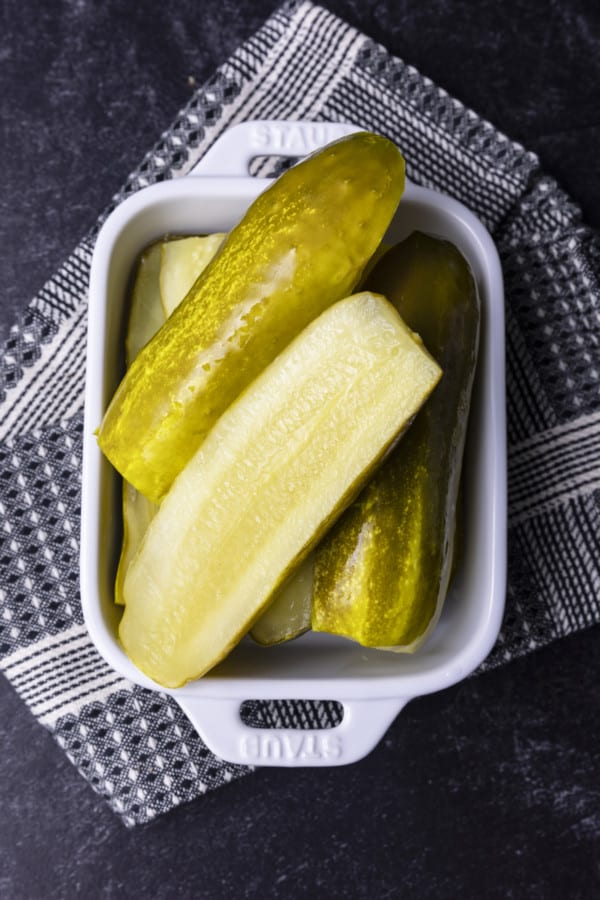
IMPORTANT NOTE: Because there is so much diversity in temperature, humidity, age of cucumbers, etc… involved in this recipe, please check your half sour pickles starting at 24 hours for doneness. If the pickles smell/taste pickley, move them to the refrigerator. Do not keep them on the counter longer than 4 days.
ANOTHER IMPORTANT NOTE: These pickles are not suitable for canning. They’re simply not acidic enough to can safely, and that is in addition to the fact that you’d ruin that perfectly crisp texture by introducing heat to the party.
What can I serve with these Homemade Claussen Knock-Off Pickles?
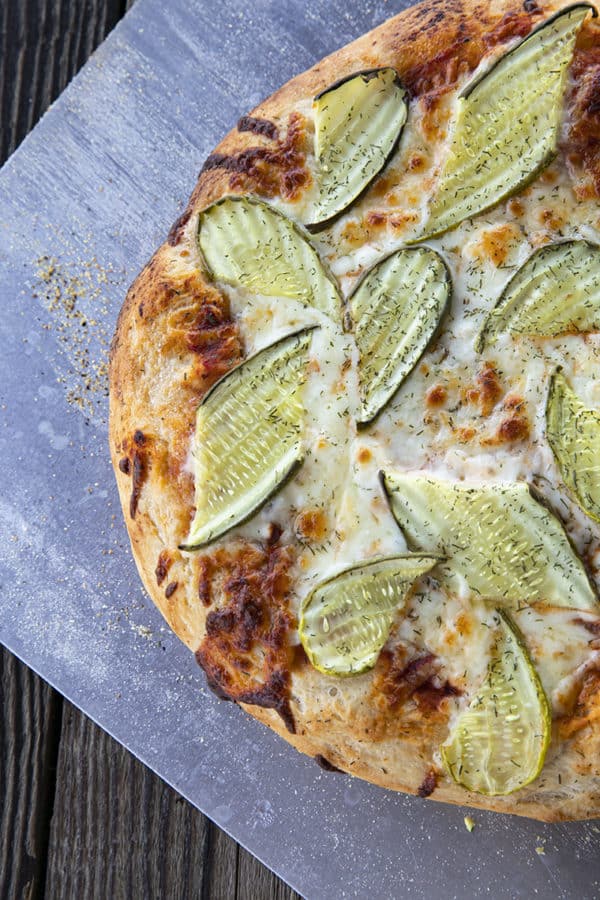
Start out by trying your half sour pickles in this Pickle de Gallo, Dill Pickle Dip, Dill Pickle Egg Salad, or Bagel Burgers with Dill Pickle Cream Cheese.
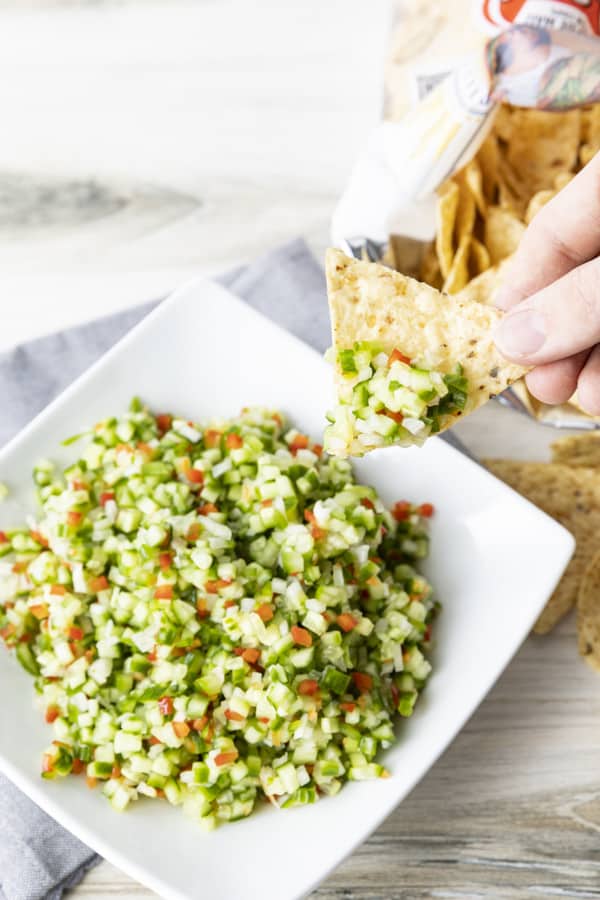
Even better, serve them on our Cheeseburger Salad or Pickle Pizza.
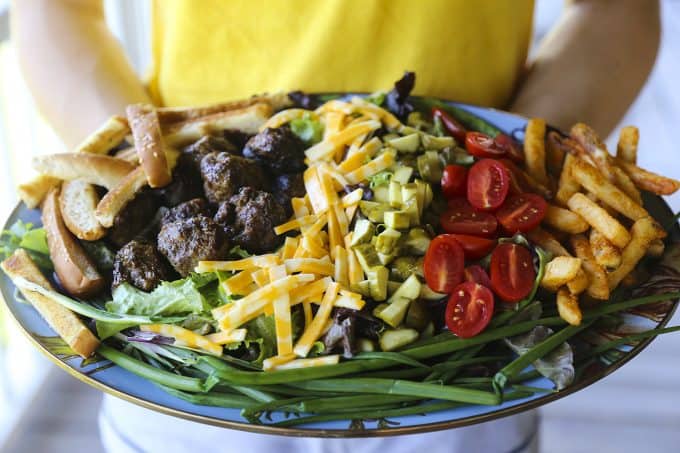
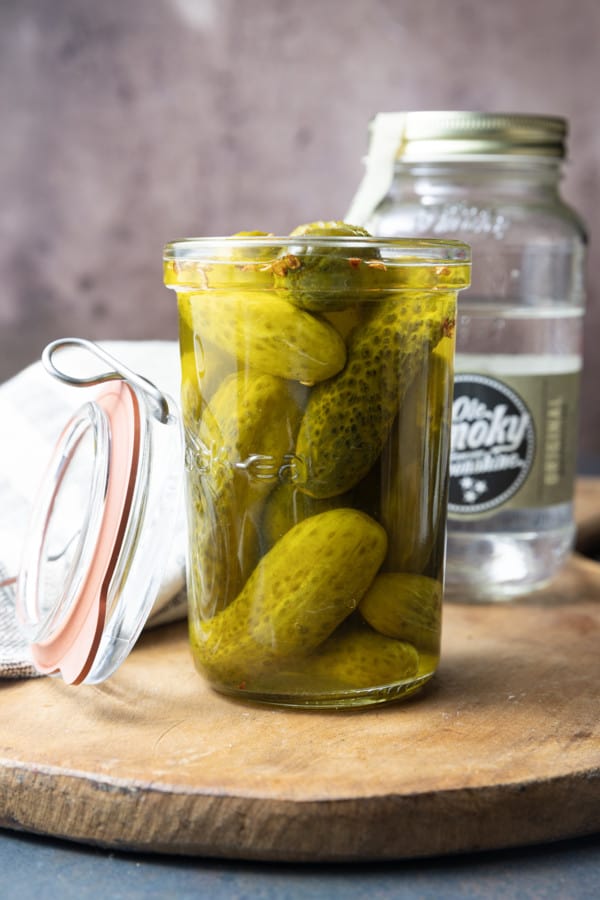
You can even take extra pickles (like that’s a thing!) and make these divine Moonshine Pickles. You’ve never had a better Bloody Mary than one made with homemade Moonshine Pickles!
Half Sour Pickle Recipe
What makes Claussen PIckles different from canned pickles? Claussen pickles, whether homemade or store bought, are a half sour pickle recipe.
That means they’re fermented instead of heat processed. That’s what gives them such great texture.
This half sour pickle recipe yields pickles that are crunchy to the point of making noise when you bite them, cold, and seriously garlicky. Canned, shelf-stable pickles can be chilled, maintain some crunch, and be as garlicky as you want them to be, but they are never, ever going to be the same thing because of science.
When you heat process a jar of pickles you are, in actuality, cooking it and a cooked pickle just plain can’t be as crunchy as an un-cooked half sour pickle recipe.
These homemade pickles keep well in the fridge for about six months, as long as they remain submerged in the brine. In our house, they never last that long because, as the saying goes, “A pickle a day keeps sad times away.”
They say that right? Someone must. If not, I’m going to start. It’s true, after all.
Claussen Pickles
Wash cucumbers but do not scrub them.
Trim 1/8-inch to 1/4-inch from the blossom end of each cucumber and slice in half lengthwise or into quarters, depending on how large your cucumbers are and how big you want them to be when they’re done.
Layer the dill heads or seed, garlic cloves, pickling spices and sliced cucumbers in a gallon jar (or large, wide-mouth, food-safe container). You can evenly divide the dill, garlic cloves, pickling spices, and cucumbers between several smaller jars if needed.
In a separate pitcher or bowl, stir together the remaining ingredients until the salt is dissolved.
Pour the brine over the cucumbers, taking care to make sure all of them are fully submerged. If needed, place a plate or mug or other non-reactive heavy item on the cucumbers to weigh them down and keep them under the brine!
Cover lightly with a lid just perched on top or secure a piece of cheesecloth over the jar with a rubber band to keep fruit flies away. Store any extra brine in a covered jar or pitcher in the refrigerator and use it to top off the brine if it starts to evaporate and expose the pickles to the air.
Leave out of direct sunlight on the counter for at least 24 hours, but up to 4 days, or until the cucumbers taste like pickles throughout.
Fix your lid onto your jar or container and chill thoroughly. These can be stored in the refrigerator for up to six months provided you keep them covered with brine.
NOTE: If at any point in the proceedings “fuzz” or “foam” develops on top of the brine, use a spoon to remove it. If there is “fuzz” attached to any of the cucumbers, remove the ones affected and be sure the others are still fully submerged.
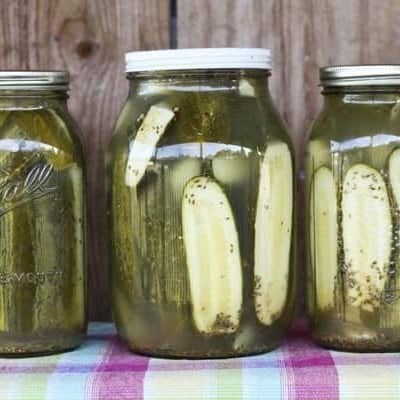
Homemade Claussen Knock-Off Pickles
Equipment
- 1 gallon jar or 4 quart jars or a large, food-safe container with a tight fitting lid
- 1 liquid measuring cup
- 1 large mixing bowl or pitcher
Ingredients
- 35 to 40 small to medium pickling cucumbers
- 1 gallon cold water
- 1 cup apple cider vinegar, preferably raw or white distilled vinegar
- 2/3 cup coarse canning or kosher salt Do NOT fine or use iodized salt!
- 4 cloves garlic or more to taste
- 4 heads fresh dill or 4 tablespoons dried dill seed not weed!
- 2 tablespoons mixed pickling spices
Instructions
- Wash cucumbers but do not scrub them.
- Trim 1/8-inch from the blossom end of each cucumber and slice in half lengthwise or into quarters, depending on how large your cucumbers are and how big you want them to be when they’re done.
- In a gallon jar (or large, wide-mouth, food-safe container) layer the dill heads or seed, garlic cloves, pickling spices and sliced cucumbers.
- In a separate pitcher or bowl, stir together the remaining ingredients until the salt is dissolved.
- Pour the brine over the cucumbers, taking care to make sure all of them are fully submerged. If needed, place a plate or mug or other non-reactive heavy item on the cucumbers to weigh them down and keep them under the brine!
- Cover lightly with a lid just perched on top or secure a piece of cheesecloth over the jar with a rubber band to keep fruit flies away.
- Leave out of direct sunlight on the counter for two to four days*, or until the cucumbers taste like pickles throughout.
- Fix your lid onto your jar or container and chill. These can be stored in the refrigerator for up to six months provided you keep them covered with brine.
- *If at any point in the proceedings “fuzz” or “foam” develops on top of the brine, use a spoon to remove it. If there is “fuzz” attached to any of the cucumbers, remove the ones affected and be sure the others are still fully submerged.
Notes
Nutrition
Nutritional information is an estimate and provided to you as a courtesy. You should calculate the nutritional information with the actual ingredients used in your recipe using your preferred nutrition calculator.
did you make this recipe?
Make sure to tag @foodiewithfam on Instagram and #hashtag it #foodiewithfamily so I can check it out!
Originally published July 22, 2011. Updated with FAQs and Troubleshooting and reposted August 2022.
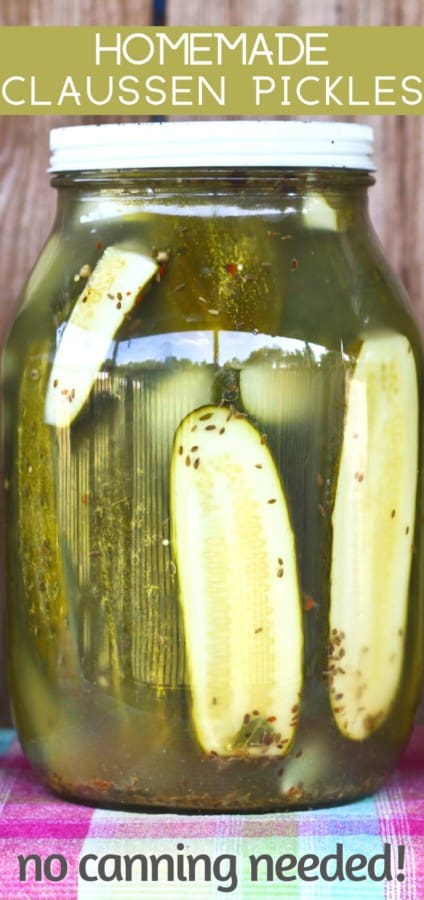
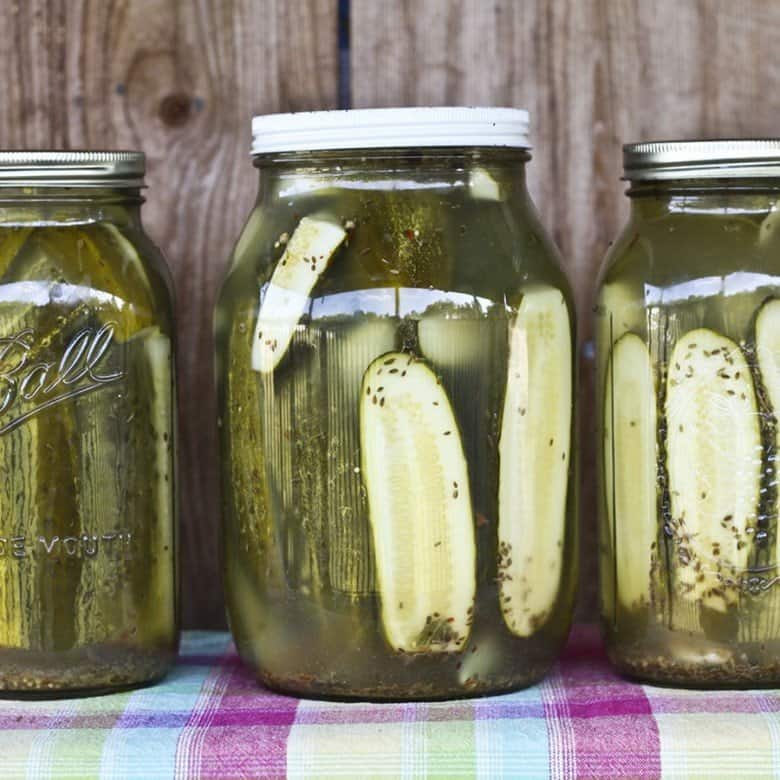
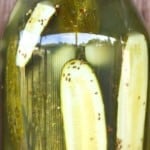



Reader's Thoughts...
Jacquelyn says
Any suggestions as to where I could buy pickling cucumbers in the off season? They are easy to find during the summer, but not in March!!!
Rudi Pittman says
I have the juice and jars from 3 jars of the claussen pickle slices…they were on clearance…any chance I could use that juice to make a follow up batch? Should I add some things? The juice tastes fine..heck I’m considering pickle juice martini’s as I type.
Rebecca says
I’ve never tried that but I’d love to know what happens if you do!
Laura Streich says
We do that, and it works!
Beth says
We’ve added our own cucumbers to the Claussen pickle juice. We actually boil the pickle juice first and let it cool. Pack the cucumbers in the jar and pur the room temp pickel juice back over and refrigerate.
Rebecca says
The only issues I have with that are that it cooks what was raw garlic, and it doesn’t get rid of the gnarly ingredients I am keen to avoid like HFCS.
Marty says
l strain the garlic & spices out & reserve them. l then boil the Clausen brine and let it cool. l add cucumbers & green tomatoes & the bribe to a sterile jar & refrigerate. lf you love dill pickles, you may also like pickled green tomatoes.
Heather says
My Brother makes these puts them directly into the fridge, and they turn out just fine.
Leslie Currie says
I think putting them in the frig is a great idea…..i do it with mine and they’re delicious……….Crispy too with the cold brine. 🙂
Andy says
Just a note on an old wives tale. Kosher salt is the same thing as table salt. One is fine grind one is course grind. Iodized salt is usually kosher (approved by rabbis for observant Jews to consume) too; the iodine is made from kelp and in such trace amounts you can’t tell the difference. All salt except canning salt have additional minerals… occurring naturally, or added to help the salt from clumping. Pure canning salt usually isn’t designated kosher ( look for a K,P or U symbol or the words Kosher for passover) but I can’t imagine why it wouldn’t be approved. Ps, Kosher Pickles (Like Kosher salt) is a style of pickle and not necessarily “Kosher” or approved by the rabbi’s for consumption. Yup, another fun fact!
Steven says
Kosher salt is labeled as such for its long use of making meats kosher, not because it was made in accordance to kosher guidelines.
Robbie says
Hey Andy,
just to hone what you said and further clarify with a slight adjustment, different grind sizes of salt (ex..table vs Kosher) will ALWAYS measure out differently , making it easy to oversalt when substituting a larger kosher style crystal for a smaller table one. More table salt fits in a teaspoon than kosher salt. As for iodized….i HEARTILY disagree. You can and most definitely WILL taste the difference ; maybe not the iodine flavor itself, but it’s effect on the salt. It somehow makes salt SALTIER (and not in a good way!) and wreaks flavor-havoc in some dishes. Back in the old days iodine was affed to prevent goiters. I wish the manufacturers would stop killing perfectly good salt with it.
Vicki says
So after I make these pickles, I leave them on the counter for 4 days, taste, and if they are perfect, I then keep them in the frig, up to 6 months?.. thank you so much, looking forward to making these tomorrow…
Charles Fantl says
Another dumb question. What is in “mixed pickling spices” or is such a mixture available at stores.
Karen B says
I saw your recipe for the pickles on the Pioneer Woman’s website. I made them last Monday – let them sit on the counter until Friday. I did four jars and let me say they are fantastic. I’ve only tasted one jar so far and we just love them. After I made them my husband (who loves pickles informed me he doesn’t like homemade pickles) well he does now! Now I’m going to try your Pickle Dip – I’ve never heard of it either….I’m really enjoying your blog!
Kiersten says
My boyfriend and I made these, after day 3 they needed another day….after day 4 they were moldy. 🙁
Ben says
I made these, yum! I used distilled water instead of tap water & sterilized everything first. In my opinion, very close to claussen. I think if one were to play with the spices instead of mixed pickling spice, one could get even closer to claussen. That said, mine are a 8 out of 10. Very good & easy to make. I’m making more tonight.
Kellie says
The reciepe for the claussen pickle was followed but the juice turned cloudy after three. They also taste a little like perfume. Don’t know how else to describe the taste.
Rebecca says
Hi Kellie… The cloudy is not necessarily a bad thing. It’s a natural by-product of fermentation. As for the perfume, I have NO idea what happened there! 🙂
TardiveZoar says
Put one slice under each arm and go to the dance. You will have many interested men.
Kari says
Hi! I Made these and the look great! I used a flat canning lid to keep the pickles down in the brine. On the second day they looked fine, on the third there was a little white fuzz above the lid, but not underneath on the pickles. Are these ok to eat if I get rid of the fuzz and refridgerate them right away?
Brian Kaplan says
Bad throw them out, also this is way to much salt and I use Durris Farms cold pack, 3 level tblspns of pickling salt. More heart healthy. Salt pomotes the celluae breakdown of tomato to allow flavor to enter. Use less salt and you can taste pickles or green tomatoes at 6 weeks.
Rebecca says
Actually, these yield delicious pickles year after year after year. There is no tomato in the recipe either. I’m not sure where that’s coming into the picture.
Davey says
Why are you talking about tomatoes??? And if you disagree with the amount of salt, perhaps post your own recipe. This amount of salt yields about 4% salinity, which is in the exact range of where you want to be for making pickles. And a little white fuzz around the top is not cause to throw the whole batch out.
Abby says
Okay, can I use cucumbers? I bought a whole mess of regular cucumbers thinking that it wouldn’t matter.
Pamela says
Made these today!
Can’t wait until Monday!!!!!!!
Rebecca says
You’ll love ’em, Pamela. I say exercise patience just a bit longer and wait until they’re chilled clean through to eat them. You won’t regret it!
Josh says
Kind of dumb question here, but when I layer the dill, garlic and cucumbers, does it matter what is on the bottom and top?
Rebecca says
That’s not a dumb question… I do the dill and garlic and spices on the bottom so the cukes hold them in place!
Tracey says
Can these be canned after the 2 – 4 days
Linda says
You will not water bath or pressure can these. You package them into jars, crocks or plastic pickle jars and do not heat them. The Cucumbers will be soggy if you do. Pack them put juice in, close lid and put them in the fridge, About a month later…ENJOY!!!
Y!!!
Dee Dee Noble says
I’ve used your recipe for the first time. I,m hoping for a good turnout. I put the pickles in a gallon jar for the four days you suggested. I want to transfer them to smaller jars but am not quite sure what to do with all those spices. Can I rinse off the spices and cover with a fresh brine without the spices for clear liquid in the jars.
C
Diego says
I’ve been trying to make a small batch actually 2 pint jars of pickles using smaller size like med. Can anyone help me with correct proportion for this small amount i want to try it. I bought the mccormick pickling spice andk i dont want to over do it. Please advise it would greatly be appreciated
Flinhir says
Wow, I have been searching all over for a crisp, claussen type pickle and you have provided the right recipe! I made some last week and they are so good I can hardly believe it. I made my own pickling spice from a recipe I found and added this to my brine. I also added fresh dill and lots of garlic. I am impressed that they are not too salty, as some dills are. I just got done with another batch, hoping this turns out as good as the first. They really are very crunchy! I am saving the brine to make a batch of bloody marys with it…if it lasts that long! CRUNCH!
jamie says
Hmmm. I cut both ends, actually. Any chance it was the amount of time in the brine? Left it in for four days, until they were not greeny cukey colored but pickley colored, then refrigerated in brine in Ball jars. I cut into spears. I used considerably less cukes than suggested. Wonder if any of that affected the result?
jamie says
So, I made these and the taste is divine but they are incredibly mushy. The cucumbers came fresh to me from a farm, so they weren’t the problem. Any ideas?
Rebecca says
There are a couple possibilities, Jamie… The most likely is that you didn’t trim a bit off the blossom end of the cucumbers. The less likely issue (but still a possibility) is that it was just that batch of cucumbers.
Tom says
Marlo, I can’t speak for others, but when I make my pickles I slice them the long way only once, giving me two halves. After the pickles are cured & ready to eat you can cut the thin slices as needed.